Artificial Intelligence (AI) has been revolutionary, showcasing immense potential in automating tasks, decision-making, and innovation. AI models are trained on a set of inputs/ techniques based on which accurate predictions or decisions are made. These techniques involve supervised learning, semi-supervised learning, unsupervised learning, and image annotation.
In this blog post we have taken a deep dive into the key artificial intelligence statistics. We’ll explore trends, industry adoption, growth projections, and AI’s impact across sectors. From automation to deep learning, these insights highlight AI’s evolving role in business, healthcare, and daily life, shaping the future with innovation, efficiency, and transformative possibilities.
For example, to train a model to identify flowers, a labeled dataset of images of flowers and their names is provided. The model would then learn how to identify patterns and differences in each type of flower.
Table of Contents
What Is Artificial Intelligence?
Artificial Intelligence (AI) is the simulation of human intelligence in machines programmed to think, learn, and make decisions. These systems are designed to perform tasks that typically require human intelligence, such as problem-solving, understanding language, recognizing patterns, and adapting to new information.
Artificial Intelligence Use Cases
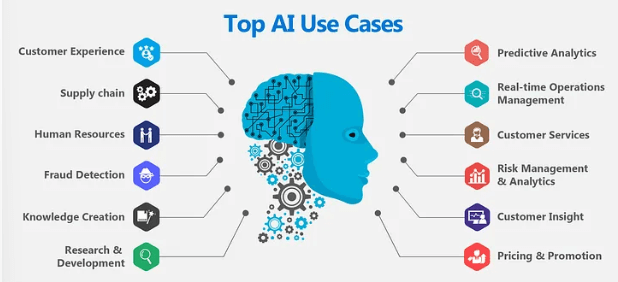
Source – WinWire
Before we dive into Artificial Intelligence statistics, let’s quickly have a look at some of its real-life use cases –
– Customer Service
AI-powered chatbots can handle basic customer inquiries and assist with tasks such as product recommendations, order tracking, and troubleshooting.
– Marketing and Sales
AI can help analyze consumer behavior to identify potential leads and further help reach them. It can also help improve sales forecasts.
– Banking
In banking, AI can help detect potential fraud, improve customer experience, manage credit risks, and improve operational efficiency.
– Logistics Management
AI can help schedule transportation, assign employees to stations, and organize cargo pipelines. It can leverage machine learning to identify damage to delivered goods.
– Healthcare
In the healthcare sector, AI can be used to continuously monitor patient data such as vital signs. It can also be used to detect changes and patterns to diagnose health issues.
– Human Resource
AI can add great value to HR processes and simplify activities related to both employee management and recruitment.
Top Artificial Intelligence Statistics In 2025 and Beyond
By analyzing data across sectors, this report offers valuable insights into the evolving AI landscape and its implications for businesses and society.
This report provides a comprehensive purview of AI’s impact, adoption, and challenges through a statistical approach. From economic contributions to industry-specific growth trends, it highlights transformative opportunities while addressing critical hurdles like ethical concerns, skill shortages, and regulatory barriers.
Artificial Intelligence Market & Adoption Rate Statistics
The artificial intelligence market is experiencing rapid growth, with widespread adoption across industries. Businesses are leveraging AI for automation, data analysis, and improved decision-making. From healthcare to finance, companies integrate AI to enhance efficiency, streamline operations, and drive innovation. As technology advances, AI continues to transform industries, shaping the future.
Key Adoption Artificial Intelligence Statistics
- In the project management market, AI is expected to grow at a CAGR of over 15% from 2024 to 2032 – Planable
- AI is predicted to reach $2.74 trillion, 4X more than $621.19 billion (2024 figure). Fortune Business Insights
- The AI image generator market valued at $336.3 million and the AI avatar market valued at $5.9 billion are projected to see a 17.5% and 30% rise by 2032, respectively – Planable
AI Usage Statistics Across Industries
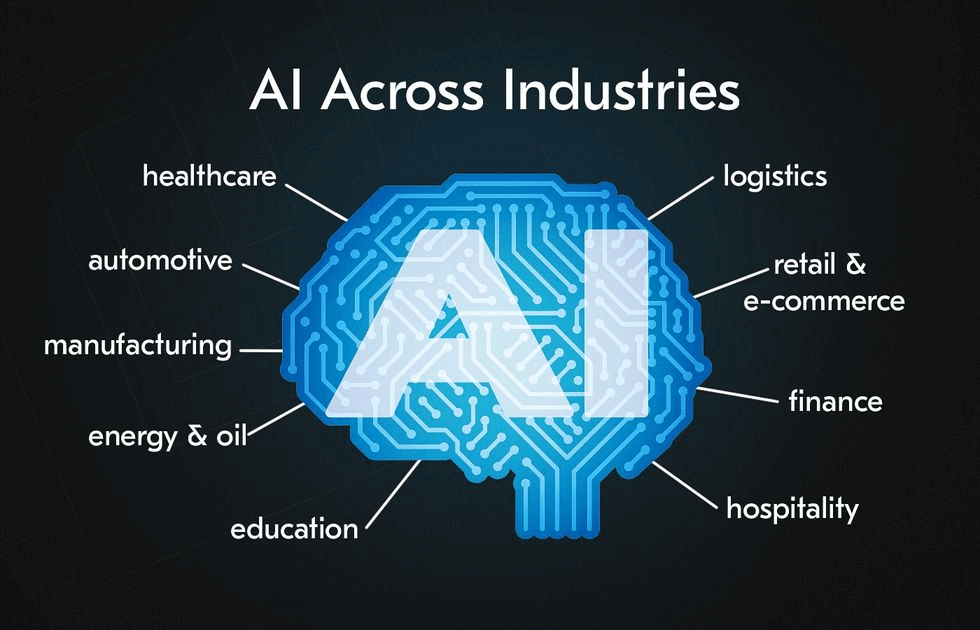
Source – Acropolium
AI’s ability lies in processing large amounts of complex data and handling complex patterns. As a result, industrial-grade AI helps companies achieve goals and accelerate digital transformation. As per the Economic Times, AI could contribute up to approximately $15.7 trillion to the global economy by 2030.
Marketing & Sales
AI in marketing and sales enhances customer targeting, personalizes experiences, automates campaigns, and predicts trends. It powers chatbots, sentiment analysis, and dynamic pricing while optimizing lead generation and customer retention. AI-driven analytics improve decision-making, content creation, and ad performance, ultimately increasing business efficiency, engagement, and revenue.
Key AI Statistics In Marketing & Sales
- AI algorithms increase leads by over 50% and reduce costs by 60% – Harvard Business Review
- 88% of marketers use Artificial Intelligence in their existing jobs. 93% of marketers use AI to generate content quicker – SurveyMonkey
- Companies using AI for sales are capable of reducing call time by 60-70% – Harvard Business Review
- Sales teams using AI are likely to see revenue increase by 1.3x – Salesforce
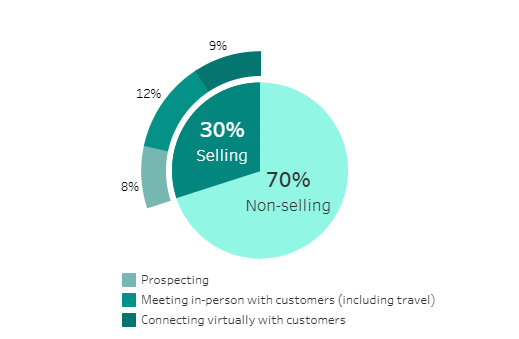
Source – Salesforce
- In e-commerce, the use of AI is valued at $8.65 billion, and it will go up to $17.1 billion by 2030 – SellersCommerce
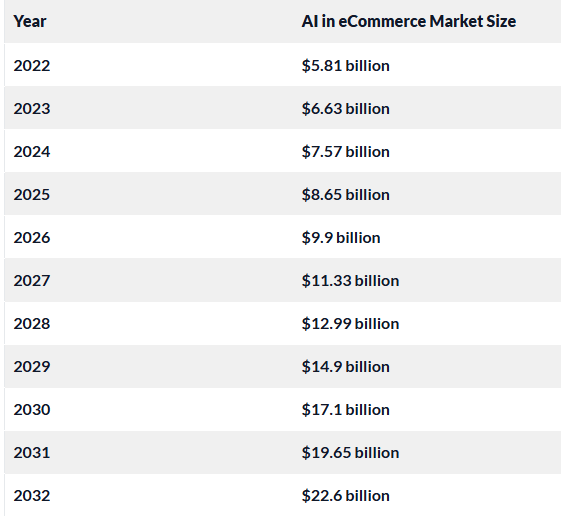
Source – SellersCommerce
Healthcare
There are multiple ways AI has been groundbreaking in healthcare. It has reshaped the way of diagnosing, treating, and monitoring patients. The technology has improved medical research as well as it has enabled more personalized treatments. The potential applications of AI are broad. For instance, AI can be used to scan radiological images for early detection or predict outcomes from electronic health records.
Key AI Statistics In Healthcare
- It is projected that AI in Healthcare Market will increase from USD 19.27 Billion to USD 613.81 Billion – Precedence Research
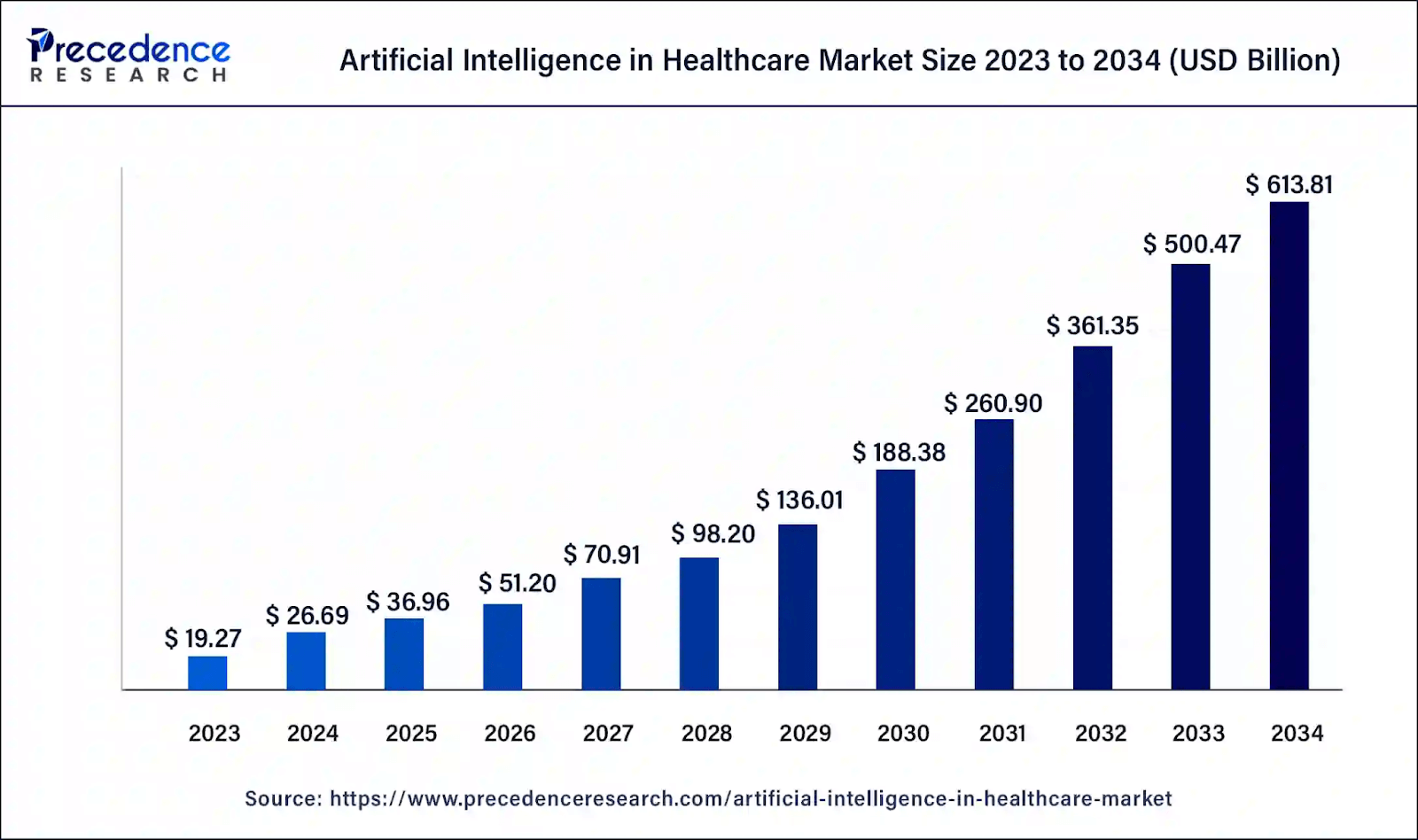
Source – Precedence Research
- The global AI in healthcare market is expected to grow at a CAGR of 36.83% from 2024 to 2034 – Precedence Research
- 75% of the top healthcare companies are either experimenting with Generative AI or planning to expand its use throughout their organizations – Deloitte
Banking
In banking, AI enhances security, efficiency, and overall customer experience. AI-driven chatbots are capable of serving customers 24/7. Furthermore, AI in banking detects fraud by analyzing transaction patterns, identifying anomalies, and preventing suspicious activities in real-time. It also studies customer behavior, personalizing services through data insights.
Key Artificial Intelligence Statistics In Banking
- Generative AI could contribute between $200 billion and $340 billion in value per year, or 2.8 to 4.7 percent of total industry revenues – McKinsey
- A collaborative study by the National Business Research Institute and Narrative Science stated that almost 32% of financial service providers have already adopted AI technologies like Voice Recognition and predictive Analytics – Star Knowledge
- AI could reduce transaction time by an average of 25% – Emerald Insights
Manufacturing
Another field that is being revolutionized by AI automation is manufacturing, where robots powered by AI are used to handle repetitive work. They also ensure that there are fewer errors with a complete focus on accuracy. Innovative systems powered by AI optimize production, saving time and costs.
- From USD 3.2 billion in 2023, the artificial intelligence in manufacturing market size is estimated to reach USD 20.8 billion by 2028, growing at a CAGR of 45.6% between the forecast period of 2023-2028 – MarketsandMarkets
- 93 percent of companies believe AI will be a pivotal technology to drive growth and innovation in the sector – Deloitte
- Among large manufacturing companies, 30% of those generating over $10 billion annually and 10% of those earning between $500 million and $10 billion annually have implemented generative AI use cases, achieving positive business outcomes. – Litslink
Retail
- In 2023, the global AI in retail market size was $ 9.97 billion. It reached $11.83 billion in 2024 and is projected to reach approximately $54.92 billion by 2033, showing a rise of CAGR of 18.6% from 2024 to 2033 – Precedence Research
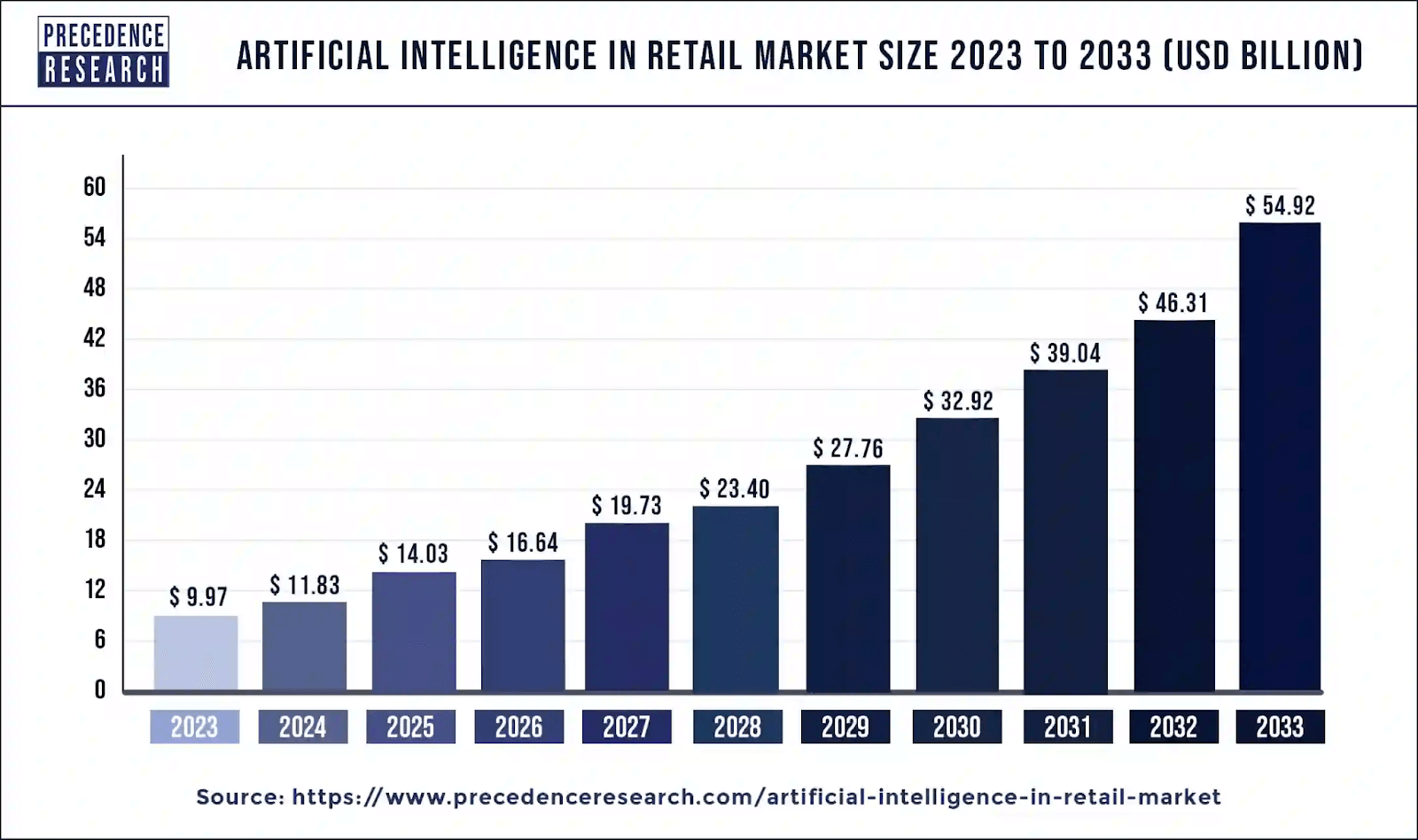
Source – Precedence Research
- The Artificial Intelligence in Retail Industry is projected to grow from $13.07 billion in 2025 to $ 53.74 billion by 2030. This implies a CAGR of 32.68% during the forecast period (2025-2030) – Mordor Intelligence
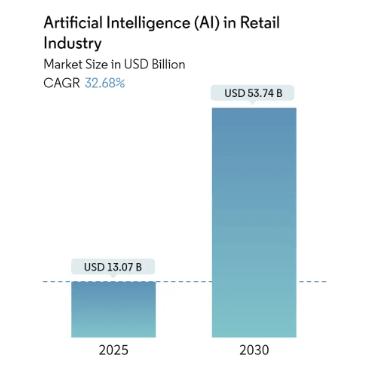
Source – Mordor Intelligence
Human Resource
- 79% of organizations have integrated AI or automation directly into their ATS – SelectSoftwareReviews
- 64% of HR professionals state that their companies’ AI or automation tools automatically screen out unqualified candidates – BusinessDasher
- 46% of HR leaders stated that AI boosted their analytics – Deel
- 45% of organizations use AI to track employees’ learning progress – SHRM
Content Creation
- 73% of respondents say that their organizations use generative AI to create images, text, videos, or other forms of content – Botco.ai
- Approximately 29% reported using ChatGPT for content-related tasks – Statista
- 63% of marketers use AI and ML software in email marketing – Capterra
Agriculture
- The size of the Artificial Intelligence in Agriculture Market is expected to increase from USD 1.7 billion in 2023 to USD 4.7 billion by 2028 – MarketsandMarkets
- A survey of 200 farmers revealed that using AI models improved the accuracy of weather forecasts by up to 85% – IndiaAI
- AI-driven irrigation systems have the potential to reduce water consumption by as much as 25% – Keymakr
- Artificial Intelligence can improve crop yield production by 20% – Omdena
Logistics
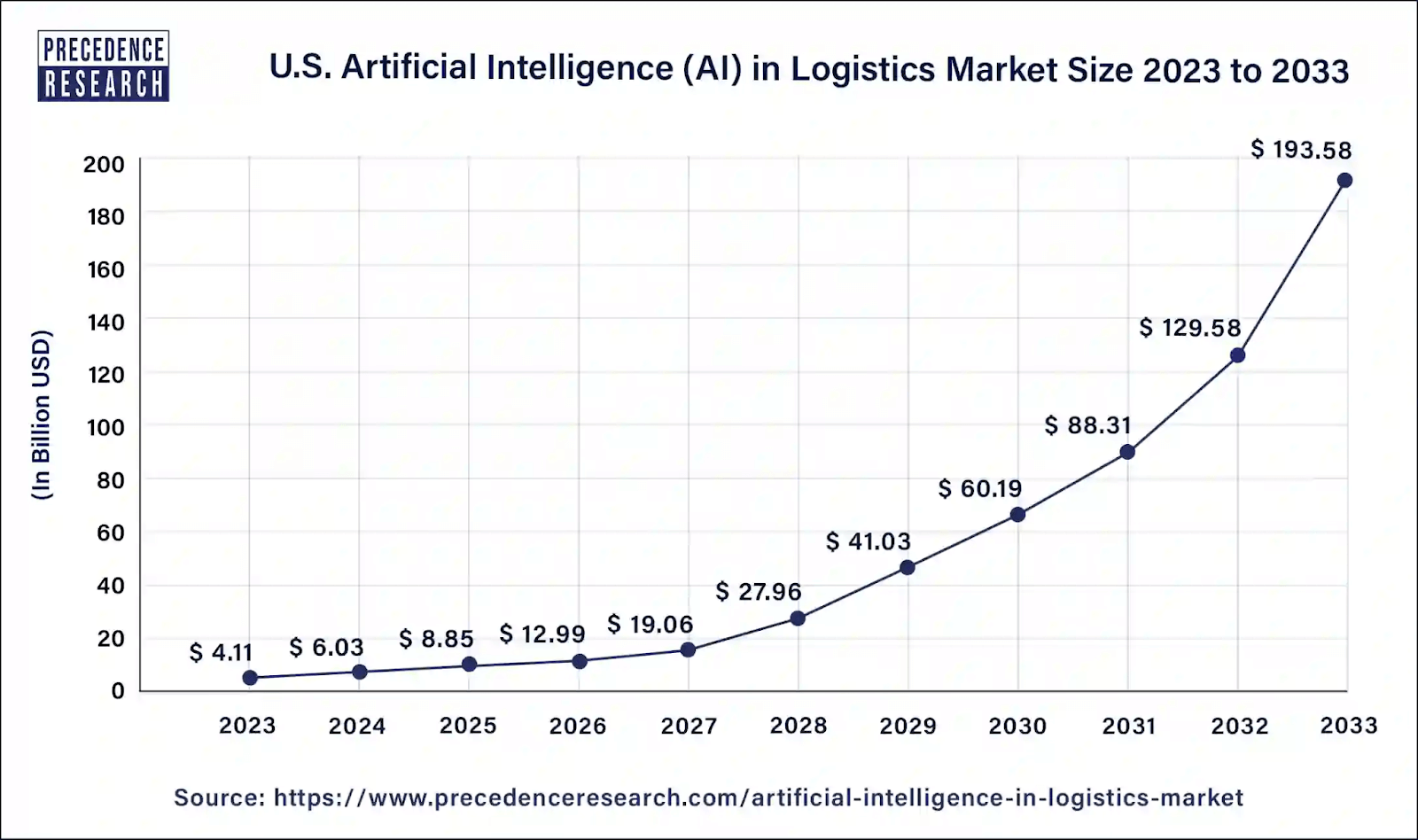
Source – Precedence Research
- Utilizing AI-powered forecasting in supply chain management can decrease errors by 20% to 50%. – McKinsey
- In 2023, the U.S. artificial intelligence (AI) in the logistics market was valued at USD 4.11 billion, with projections estimating it will reach approximately USD 193.58 billion by 2033. – Precedence Research
- The worldwide cargo drone market is set to increase to $17.88 billion by 2030 – Statista
- Logistic companies will contribute $1.3-$2 trillion per year for the next 20 years in economic value – McKinsey
Adoption of AI in Law Firms
- Approximately 65% of law firms believe implementing AI can accelerate their tasks. – DocuEase
- As per a 2023 study by Goldman Sachs, 44% of work tasks performed in the legal industry can be automated by AI. It further states that AI might replace 40% of employees in the legal domain.
- 82% of lawyers either use or plan to integrate AI into their practices – Pinsent Masons
- The size of the legal AI software market is expected to increase from $1.53 billion in 2024 to $14.62 billion by 2035 – Roots Analysis
AI Skill Demand & Employment Statistics
- By 2050, it is predicted that AI will take 20 percent of jobs – IFA Magazine
- The average total pay of an AI engineer in the US is $2,04,165 per year, with an average salary of $1,33,507 per year – Glassdoor
- By 2030, an estimated of 20 million to 50 million new jobs will be created across a wide range of sectors such as finance, healthcare, technology, and more – McKinsey
- AI skills are growing 3.5X faster than globally for all job postings – PwC
- The global AI training dataset market size was estimated at $2.60 billion. It is projected to grow from 2025-2030 at a CAGR of 21.9% – Grand View Research
A Statistical Perspective On Investments in Artificial Intelligence
- By 2025, surveyed retail and consumer products companies plan to allocate the equivalent to $33.2 million annually for a $1 billion company, which means an average of 3.32% of their revenue to AI—- IBM
- Currently AI technologies account for $12.4 billion of global investment. This number is projected to increase in the next three years. 40% of executives are expected to increase their AI investments by 20% or more – KPMG
- By 2028, global spending on Artificial Intelligence will reach $632 Billion – IDC
AI Stats in Customer Service
Artificial Intelligence is used to scale and optimize various aspects of customer support. Furthermore, it revolutionizes customer service by enabling 24/7 support by automating routine inquiries, enabling support through chatbots, and providing accurate and instant responses.
- AI will power 95% of customer interactions – Tidio
- 80% of companies will be using or planning to use AI-powered chatbots by 2025 – Plivo
- 77% of CRM leaders say that by 2025, AI will be able to resolve the majority of tickets, and it won’t need a customer service representative – Hubspot
- Conversational AI is projected to reduce contact center agent labor cost by $80 Billion in 2026- Gartner
AI Stats Country Wise
- The U.S. is the global leader in artificial intelligence, followed by China and the United Kingdom – Stanford University
- Singapore stands as the most AI-prepared country with an AI preparedness index of 0.8, followed by Denmark and the United States with the score of 0.78, and 0.77 respectively – International Monetary Fund
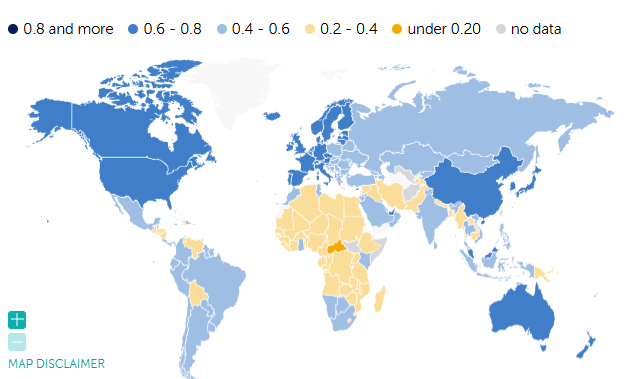
Source – International Monetary Fund
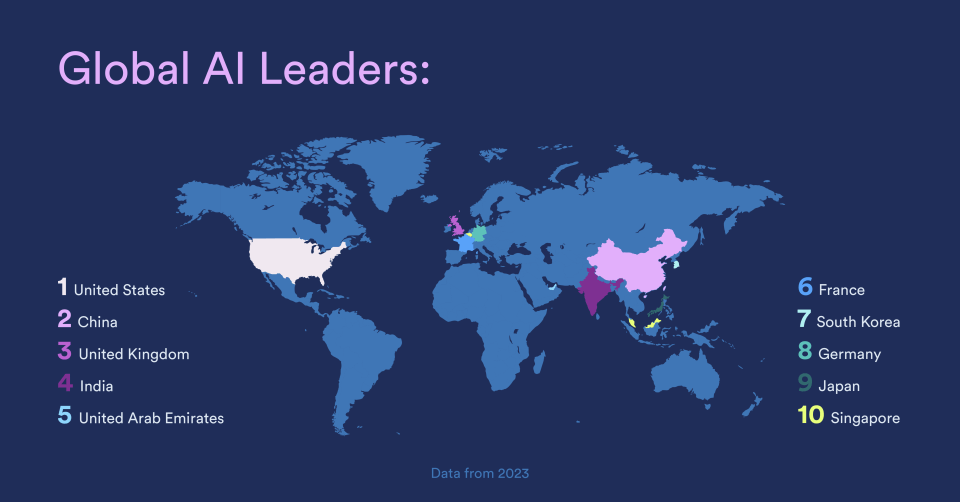
Source – Stanford University
- North America holds the largest regional market share for AI-powered software. Furthermore, in 2024, North American-based companies contributed 43% of total AI software investment – ABI Research
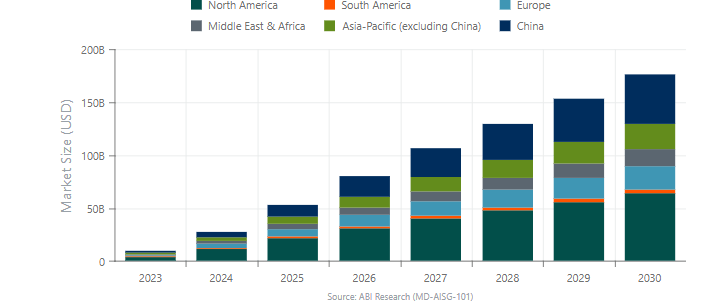
Source – Allied Business Intelligence
Statistics Depicting Challenges In Artificial Intelligence
AI has a lot of potential, but there are still challenges that need to be addressed. For instance, shortage of skilled talent, implementation costs, cybersecurity risks and issues with data quality, and many others create hindrances when it comes to adopting Artificial Intelligence.
- 60% of IT professionals feel they are not prepared to counter attacks and threats raised by AI – Darktrace
- The carbon footprint of training a single language model is approximately 600,000 pounds of CO2 emissions – Forbes
- It is expected that 92% of IT jobs will be transformed by AI, rendering 74% of IT professionals fear that AI will make their skills obsolete – CIO
- 55% of data experts were concerned that LLMs may expose sensitive information – Security Magazine
- 81% of employees in production have reportedly never used AI. 15% of employees say that they use AI but weekly – Gallup
Device-Wide AI Usage Statistics
- The global voice recognition market is projected to reach $50 billion in 2029 – Statista
- 77% of devices today use AI technology – Simplilearn
- When choosing a smartphone, 60% of consumers consider AI features important – YouGov
AI Statistics in Education
- 86% of students use AI in their studies – Digital Education Council
- The global AI in education market is expected to reach $6 billion by 2025 – AIPRM
- In a survey of 1135 educators, it was found that almost 58% had no training on AI – EducationWeek
AI Demographics Statistics
AI Usage Statistics By Age
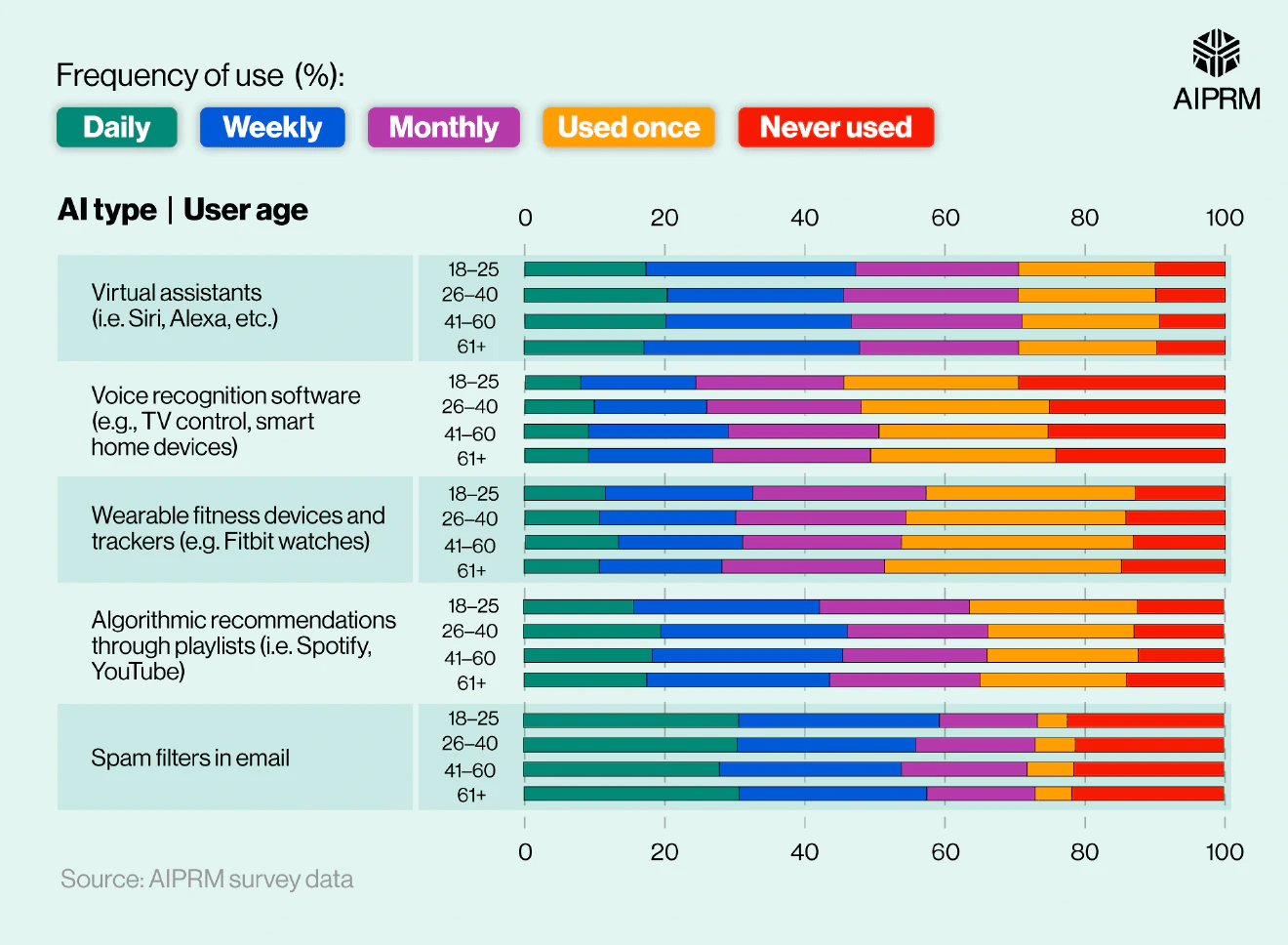
- Approximately 18%-30% of users between the ages 26-40 get algorithmic recommendations through playlists on Spotify, YouTube, etc – AIPRM
- Approximately 18%-50% of users between the age of 18-25 use virtual assistants like Siri, Alexa, etc. – AIPRM
- Adults in the United States say that AI has had a very positive or somewhat positive impact on their lives. Only 12.72% say that AI has a very negative or somewhat negative impact on their lives – Statista
- Approximately 68% of non-AI users are Baby Boomers or Gen X – National University
AI Usage Statistics By Gender
- Men have slightly more awareness of AI than women (38% Vs. 23%) – National University
- 41% of women believe gen AI will negatively impact employment opportunities versus 35% of men – Cognizant
- Women working in the tech industry appear to be using gen AI faster than their male counterparts (44% Vs. 33%) – Deloitte
AI In Cybersecurity – A Statistical Approach
- 93% of security leaders anticipate that their organization will face daily cyberattacks – Netacea
- The global AI in cybersecurity market is projected to surpass 146.52 billion by 2034 – Precedence Research
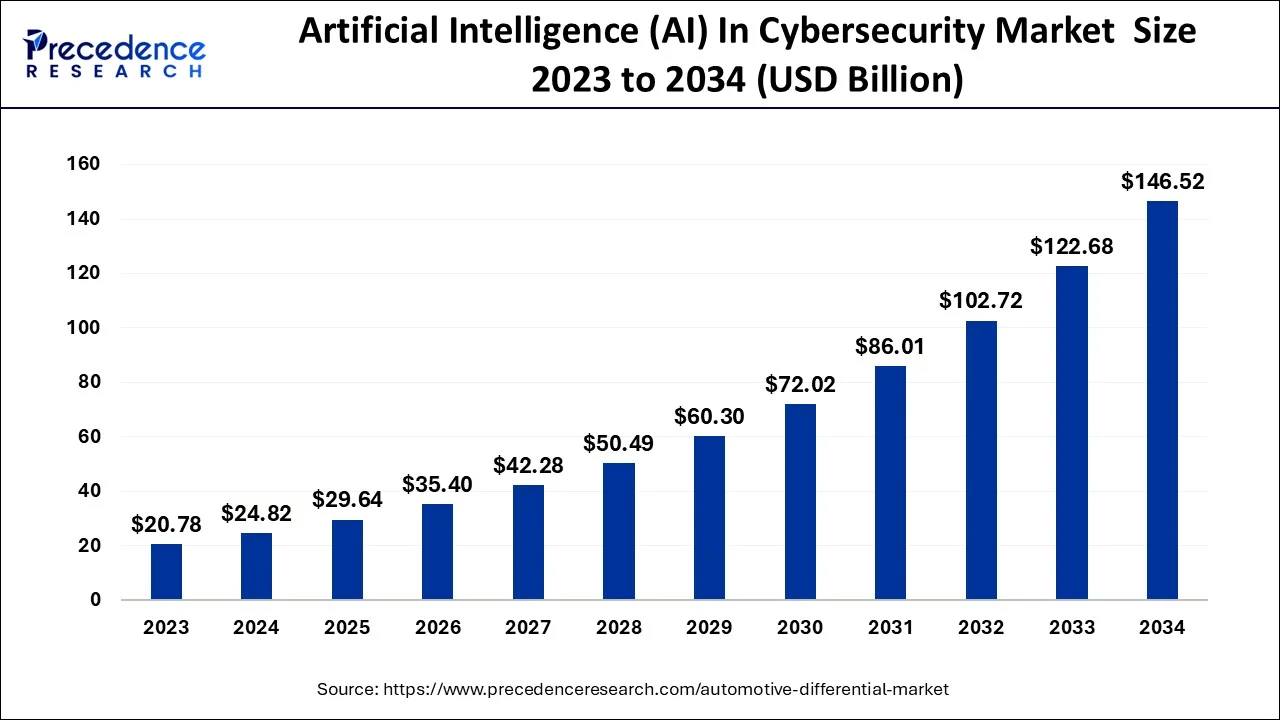
Source – Precedence Research
- 73% of cybersecurity teams wish to focus on AI-powered prevention strategies – Deep Instinct
- AI-based tools are 300% more accurate than traditional tools at detecting attempts by malicious scripts – StationX
Are you Looking to Leverage AI for your Business?
A3Logics is a leading AI development company that modernizes businesses with adaptive AI software services. Here are some reasons why you should consider hiring adaptive AI developers from A3Logics –
- As an AI development company, we leverage AI-driven automation, advanced analytics, and machine learning to streamline operations.
- Harness the potential of NLP, neural networks, and other subsets of AI to create cutting-edge solutions to increase efficiency.
- We develop solutions such as chatbots, and predictive analytics that give feedback to consumers in real-time.
- Continued maintenance and support services to improve system functionality.
Wrapping Up
By observing AI trends closely, we can conclude that in the near future, AI will have a huge impact on both personal and industrial level. AI is already a pivotal driver of emerging technologies like robotics, big data, and IoT, and generative AI has further expanded the possibilities of AI. As LLMs are trained on more specific datasets, they can provide deep expertise for specialized industries. We can expect intelligent automation, enhanced decision-making, personalized experiences, and more intuitive systems.





